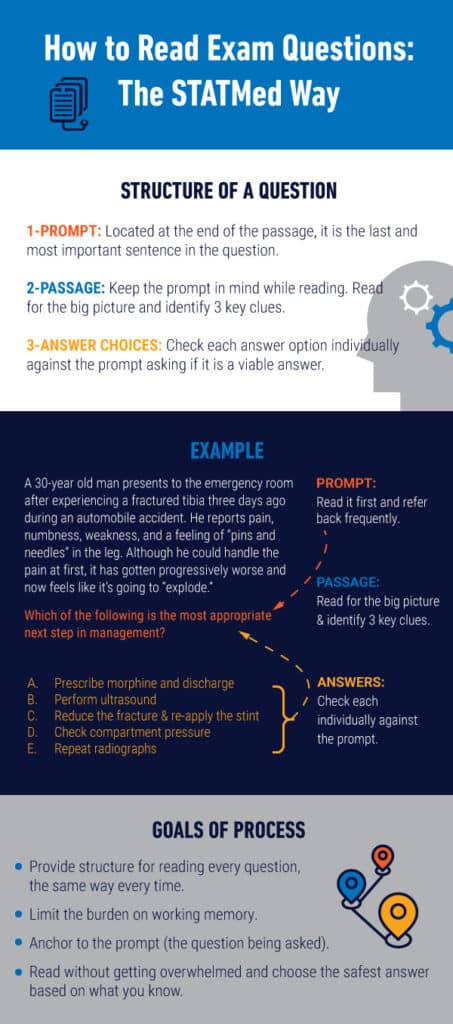The STATMed Way to Read Medical Learning Test and Board Exam Questions
Have you struggled with — or even failed — your medical boards? You’re not alone. Bad test-taking is a thing. And even incredibly smart students and doctors can have trouble with these exams. Surprisingly, the way you’re approaching board exam questions could be the problem.
Over the years, we’ve worked with a variety of med students and professionals and have noticed five common issues “bad test-takers” experience. So, to help head off these problems, we’ve created a five-part series where we dig into the top reasons people have struggled with boards (or other tests). One thing we’ve noticed? How you read and process board exam questions can make a big difference.
Now, before we dig into the method we recommend, we’ll start by saying this: no two learners are exactly alike. What works for some people might not work for you, and vice versa.
We believe that many “bad test-takers” are really struggling with working memory overload. You can learn more about our unique theory on that here. Others may have underlying issues like ADHD. Still others may be falling into various test-taking traps, such as the trap of familiarity or a binary test-taking mentality. To counter all of this, we’ve designed a process for reading board exam questions that helps you to reduce the burden on your working memory and to continually focus on the problem to be solved. It’s by no means the only “right” way to work through board exam questions, but it works well for many of our students.
Our Process for Reading Board Exam Questions

Start with the Prompt
When it comes to board exam questions, we believe the prompt is the most important sentence of all. So we always start by reading it first and taking a moment to fully process all aspects of the problem to be solved. Because the prompt typically isn’t loaded with clues or the medical terminology students and physicians are trained to look for, all too often we see our students glaze over this important piece of the puzzle. And then their brains fill in the question they think or assume is being asked… and if you’re answering the wrong question, you’re likely to provide a wrong answer.
Find Three Clues to Solving the Problem in the Passage
Once you have a solid understanding of the question to solve for, then we go back and read the passage, or the vignette, explaining the situation. Read for the big picture, and as you’re reading the passage, be sure to keep the prompt in mind and in focus. After you’ve read through the information provided, try to identify three key clues.
Why three? Noting three clues prevents us from falling into two types of traps: 1) latching onto a single clue and putting undue weight on it, or 2) feeling so overwhelmed that you hold onto nothing substantive. Obviously, some people might find that four clues work best for them, or that they’re able to process five or six. But if you find yourself feeling lost in or overwhelmed by the passage, this strategy can help.
Check Each Answer Choice Individually Against the Prompt
Now that the clues you’ve identified have given you a better understanding of the situation, we turn our attention to the answer options. Here, we recommend evaluating each option individually, asking each time “is this a viable answer to the prompt?” Taking each option back to the prompt one at a time turns each question into a series of mini-questions, allowing you to rule out options that aren’t viable. Once you’ve narrowed it down to only viable options, then evaluate each remaining option against the prompt while asking “Is this the safest answer based on what I know?”
This one-by-one process keeps all aspects of the prompt front and center in your brain, helping to ensure you answer the question that’s actually being asked. Asking which is the “safest” answer helps you keep in mind subtle cues like “what is the most appropriate next form of treatment” or “what should you be most concerned about?” Adding the caveat “based on what I know” is a reminder that you don’t have to know everything about a topic to identify the right answer. It helps you avoid binary test-taking mentality, which is basically “I either know everything about it and will get the answer right, or I don’t know everything I feel I need to so there’s no way I can answer this.”
And that’s it. We’ve found using this same structure every time helps many of our students stay focused and avoid becoming overwhelmed while working through complicated board exam questions and boards-style tests.
Looking for more advice for passing medical board exams?
Check out our series on the 5 test-taking problems we see most often.
So, how do you know if you’re a bad test-taker or if it’s another issue? If you frequently realize that you could have gotten several board exam questions right after reading the answer explanation, it may be a test-taking problem. But, if you read through and don’t experience that “lightbulb” moment, you may not be studying effectively, which is a different situation entirely.
